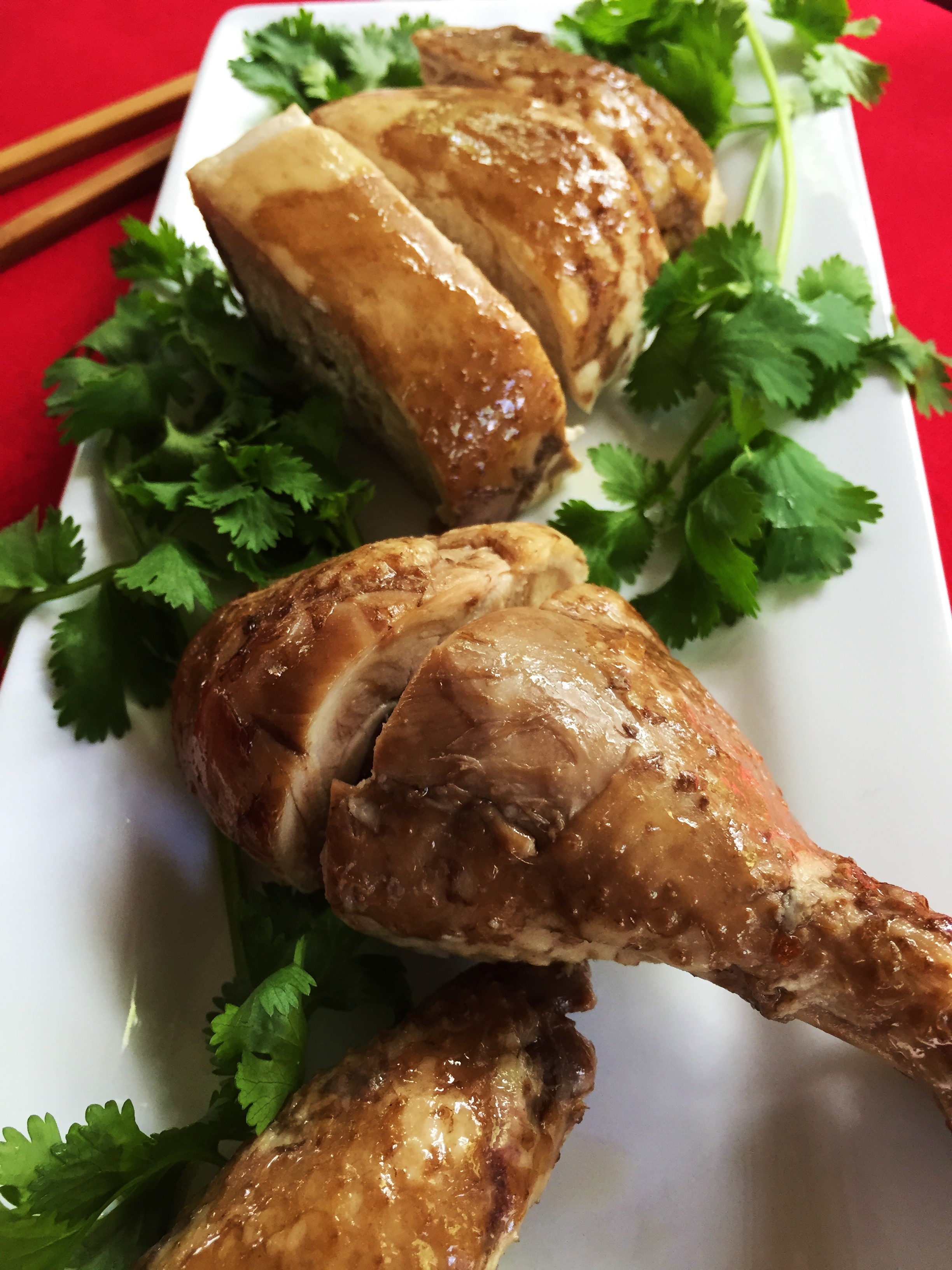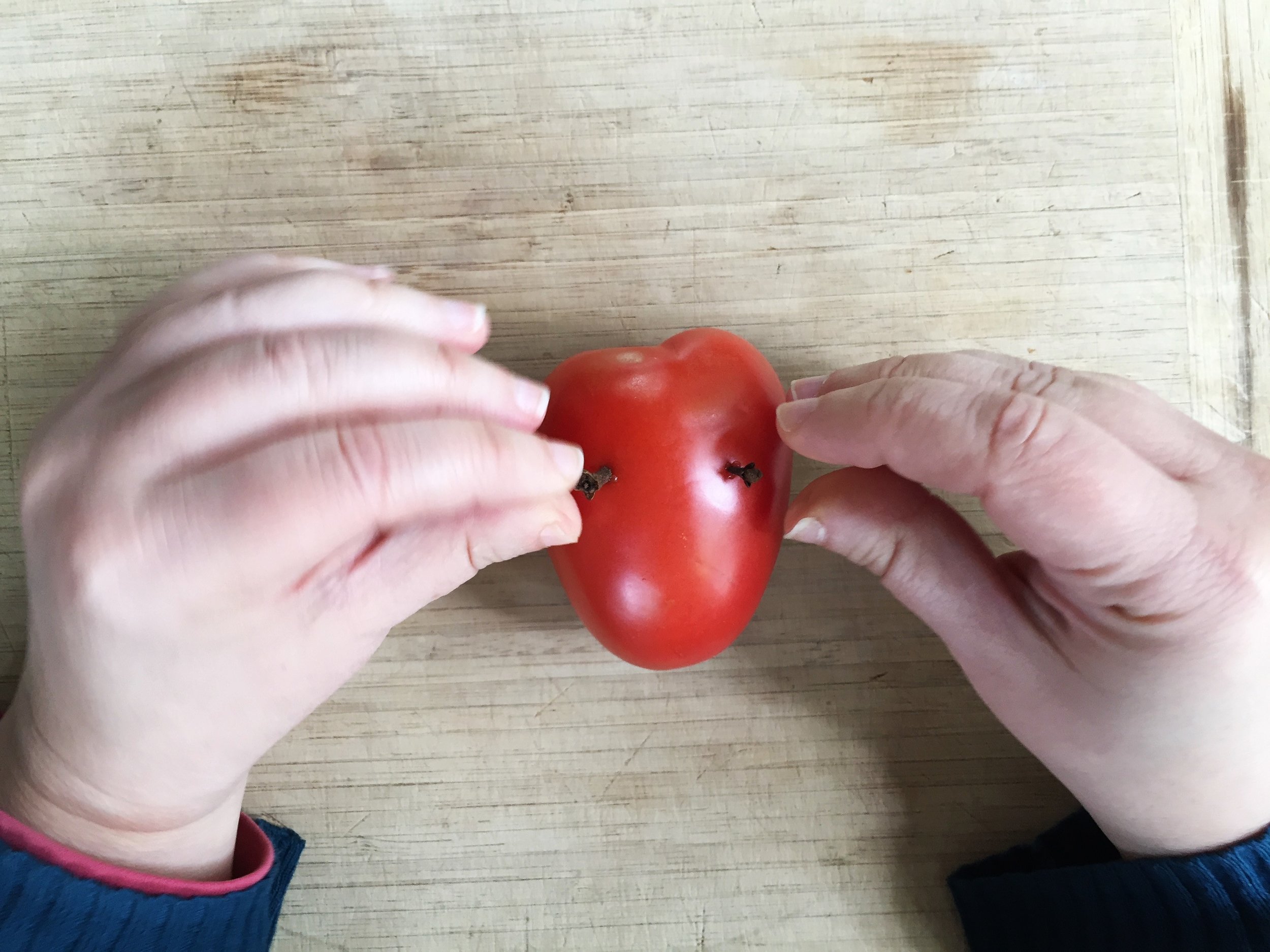Lucky Chinese 5-Flavor Chicken
Lynley Jones
Whole chicken poached in a broth of soy sauce, wine and spices. Brings good luck to your new year table, and delicious adventure anytime. Visit the Why Did the Chicken Cross the Globe? series that inspired this recipe.
Serves 4-6
Note that this dish should be cooked a day ahead, then rest in the refrigerator for 24 hours before being plated and served.
Ingredients
About 14-16 cups cold water
1 1/2 cups soy sauce (not low-sodium)
3/4 cups white wine (Chinese rice wine, dry French vermouth, or any inexpensive, drinkable white wine will do)
6 ounces Chinese rock sugar (available at Asian market), or 3/4 cups white granulated sugar
2 Chinese 5-spice packets (available at Asian market, see notes for important tips and substitutions)
1 whole chicken, about 5 pounds (giblets removed)
For Chinese New Year garnish:
1 plum tomato, 2 whole cloves, 2 scallions, 1 bunch cilantro and (optional) sesame oil
Instructions
1. Select a heavy pot with a lid, large enough to immerse your whole chicken. Confirm this by putting the whole chicken into the pot, then adding 14 cups of cold water. (You may want to leave the chicken in its packaging at this point, or put it in a large zipper bag before you do this. Less mess.) Depending on the size of your chicken and the size of your pot, you may need more or less water, but the chicken should be fully immersed, while leaving enough room in the pot for the water to boil. (My All-Clad stock pot was perfect for this.) Once you are sure you have the right pot, with the right amount of water in it, remove the chicken and set it aside, leaving the water in the pot.
2. Stir the soy sauce, white wine, sugar and whole 5-spice packets into the water. (Keep the cloth spice packets intact! See notes.) Put the lid on and bring the mixture to a boil over high heat. Once the mixture has begun to boil, turn the heat to medium-low, put the lid askew and simmer for 30 minutes.
3. After 30 minutes, stir the sauce to redistribute the spice sediment throughout the broth, then carefully lower the chicken into the pot, breast side down (this will allow the breast skin to brown). Turn the heat to high with the lid askew and bring it back to a boil. Once it has begun to boil, turn the heat back down to medium-low to maintain a gentle simmer.
A sturdy porcelain bowl keeps the chicken submerged.
4. Gently simmer the chicken, submerged in the liquid, with the lid askew for 40 minutes. If your chicken is positioned breast side down, it will probably be about 95% submerged with just a small portion of the back emerging from the broth - this is perfect! If your chicken instead wants to float or turn over, you can weigh it down with a bowl on its back as it simmers away (see picture).
5. As the chicken cooks, the skin will brown in the liquid. This browning might be uneven, depending on how the chicken is resting in the liquid. To help your chicken achieve a more even coloration, you may want to occasionally stir the broth and move the chicken around in it. Be careful not to tear the skin! One way to do this is to lift the chicken a bit with the handle of a wooden spoon in the cavity, briefly stir the liquid with a separate spoon, then lower the chicken back into the pot.
6. After 40 minutes, remove the pot from the heat and remove the lid. Do not overcook, or the chicken will begin to fall apart. (You need it to remain whole for cutting and final presentation!). Allow the chicken to rest and cool in the broth for 1 hour with the lid off (again, stirring occasionally if you'd like to minimize uneven coloration). After an hour, carefully lift the chicken from the broth and transfer it to a large (2-gallon) zipper bag or a large bowl. Give the broth a good stir, then add about a half-cup to the chicken. Position the chicken so that the breast and top (or any parts that didn't properly color) are lying in the broth. Cover the bowl (if using) with plastic wrap. Put the chicken in the refrigerator to rest for 24 hours, shifting the chicken in the broth every few hours as needed to even out the color. (Refrigerate the rest of the broth to use in Green Garlic Noodle Bowls or another dish!)
Notice the stripey color of our chicken! It seems this is par for the course, but you can help minimize it by stirring the cooking liquid and shifting the position of the chicken periodically as it rests overnight. When it's time to serve, strategic use of cilantro garnish can help camouflage any unevenness.
7. When you are ready to plate the chicken, take it out of the refrigerator and discard the sauce (or combine it with the rest of the sauce you saved from the day before). Put the chicken on a large, sturdy cutting board and use a cleaver (or whatever knives you are comfortable with) to cut the chicken into chopstick-sized pieces as shown in this post.
Don't use knives with a serrated blade, as they could tear the skin and flesh and the presentation won't be quite as nice.
Presentation
Once you have cut your chicken into chopstick-sized serving pieces as described here, you can choose how to plate the pieces. On Chinese New Year, it is traditional to serve every single piece of the whole chicken together, including the feet and head! This is for good luck in the new year, and symbolizes togetherness and completeness.
Since we don't get chickens with their heads and feet intact in the United States, it's common to use a tomato to represent the head, and scallions to represent the feet. Cloves stuck into the tomato represent the chicken's eyes.
Chinese New Year Presentation:
Our final presentation. Note that we used quite a bit of cilantro on top of the breast pieces to disguise the uneven coloration. If you don't have that problem, you may want to use less garnish on top so you can show off your beautiful chicken pieces better.
Arrange the pieces on a platter in the rough shape of a chicken, as shown (step-by-step instructions below). You can arrange the pieces in any way that seems attractive, and use copious amounts of cilantro to hide variations in the coloring of the skin.
For a bountiful New Year, the pieces should be crowded together on the platter so that you cannot see the platter amidst all the chicken pieces, and the edges of the platter should be garnished with cilantro to cover. You can overlap pieces as needed, placing plumper pieces on top of any that are bonier or may be less visually appealing to your guests.
Arranging the Chicken Pieces
1. Backbone pieces are laid down the center of the platter:
2. Lay the breast and side/back pieces along either side of the breastbone:
3. Lay the thigh and drumstick pieces along either side of the rest of the pieces:
Once you have the pieces positioned on the platter, you can brush them very lightly with sesame oil (but go easy - a little goes a long way).
Adding the "Head" and "Feet"
Since in the US our chickens do not come with their heads and feet still attached, a tomato and scallions are often used to represent the head and feet of the bird. This still counts as serving the complete bird!
Use a plum tomato for the head, and stick cloves into it to represent eyes.
Use scallions for the feet. Remove the root ends, then cut into the white ends of each scallion vertically.
Spread the white cut ends apart to represent chicken feet.
Final Presentation
Position the head and feet in their proper places on the platter. Garnish with lots of cilantro to be sure the platter looks bountiful, and there are no places where you can see the platter underneath the chicken.
Serve on red table linens for good luck.
Serve cold and enjoy!
Notes:
If you don't have a pot that's large enough for the whole chicken plus all the liquid, you can still make this dish using 2-3 pounds of chicken parts (bone-in, skin on), and halve all the other ingredients. To achieve the whole-chicken Chinese New Years presentation with a smaller cooking pot, cook all the pieces of a whole chicken in batches, halving the broth ingredients.
Here is a picture of the 5-spice packets I found at my Asian market:
I opened one of the packets so you could see the spices inside, but the cloth packets are designed to be used intact (like tea bags!). The water passes through the packets to infuse the broth.
If you can't find these 5-spice packets, you can substitute the following:
4 teaspoons fennel seeds
1 teaspoon whole cloves
1/2 teaspoon cumin seeds
Combine these in a tea ball or tie them up into a cheesecloth pouch, and drop it into the broth along with a pinch of ground ginger.
Thank you to Amy Rabb-Liu for the original version of this recipe.
Our flavorful organic cumin seeds come from India and Turkey. These high-quality cumin seeds have a robust flavor and a gorgeously deep brown color, flecked with green and gold. Cumin is a classic ingredient in cuisines around the world, including Indian, Mexican, Middle Eastern and many others. Use them whole in rice, curries, beans and soups to infuse the dish with flavor. Or crush them with a mortar and pestle to sprinkle on meats and taco toppings.
1/2 cup-sized jar.
















